A Private Tour today, and rather different to a normal day. There were some specific target birds we wanted to find and we would mostly be avoiding the coast. It was rather cool, in a blustery north wind, which in theory was not ideal for what we wanted to see, but you never know how things will turn out!
Our main destination this morning was up on the Heath. We particularly wanted to see Dartford Warbler and Turtle Dove. We walked up to one of the favourite places for Dartford Warblers, but it was rather exposed and windy here. A quick circuit around the heather and gorse produced a pair of Stonechats, the male quite a strikingly pale individual, a smart male Yellowhammer singing and the usual smattering of Linnets.
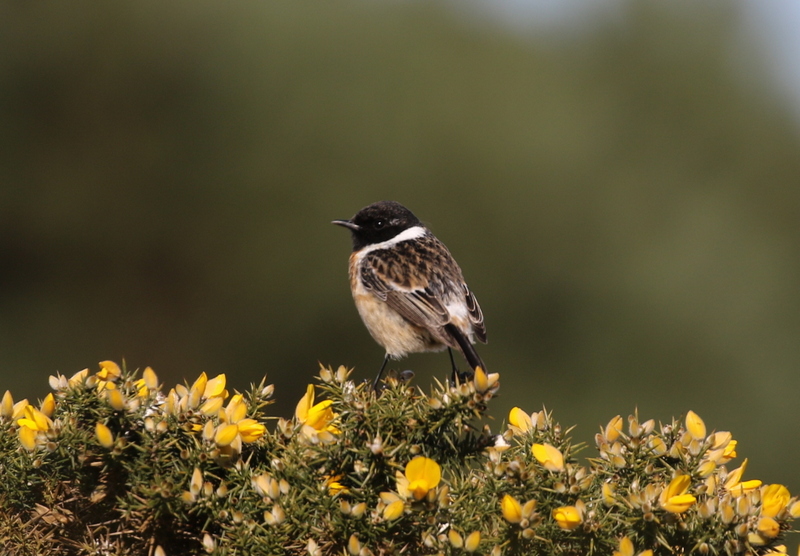 Stonechat – the male, taken earlier in the year on a sunnier day!
Stonechat – the male, taken earlier in the year on a sunnier day!
The melancholy song of a Woodlark drifted over towards us and a quick scan of the sky revealed it in full song flight, fluttering hard, but only making slow progress forwards as it sang.
With no sign of the Dartford Warblers here, we thought we would try another favoured spot across the Heath. The walk across there was quieter than normal, with many of the warblers in particular rather subdued due to the wind. Still, we did hear several Willow Warblers, a Common Whitethroat and a Blackcap singing from deep in the trees. As we came around a corner, another Woodlark flew up from the path in front of us. It flew up into the sky away from us, then turned and started singing.
Unusually, we saw the Turtle Doves before we heard them. The male flew up from some dead trees and started to glide round in a wide circle, with tail spread and wings held out, its distinctive display flight. When it landed back in the dead trees again, the female Turtle Dove flew in too and alighted nearby. The male then performed its bowing display to the female, bobbing up and down on a branch. All great to watch. He then settled himself down and started purring, such a wonderful sound and very sad it is not heard so often these days.
When we heard Linnets and Yellowhammers calling agitatedly, we looked up to see a small falcon flying over. The shape, with swept-back wings, immediately told us it was a Hobby and a quick look through binoculars revealed a slate grey back, black head with white cheeks and, as it banked, its rufous trousers. It flew through fast, just above the tops of the young trees, before dropping over the ridge and away out of sight. A nice bonus.
The Turtle Doves were flushed by some passing walkers and flew across to land in a nearby pine tree. We worked our way round so we could see the male on a branch and he started to purr again.
 Turtle Dove – the male was purring to the female
Turtle Dove – the male was purring to the female
A Woodlark started singing again and we turned to see one land in the top of one of the dead trees back where the Turtle Dove had just been. This time, we got it in the scope and had a much better view of it, noting the distinctive face pattern and strongly marked supercilium. A second Woodlark was singing in the sky, further back beyond it. Another male Stonechat appeared in the same dead tree too.
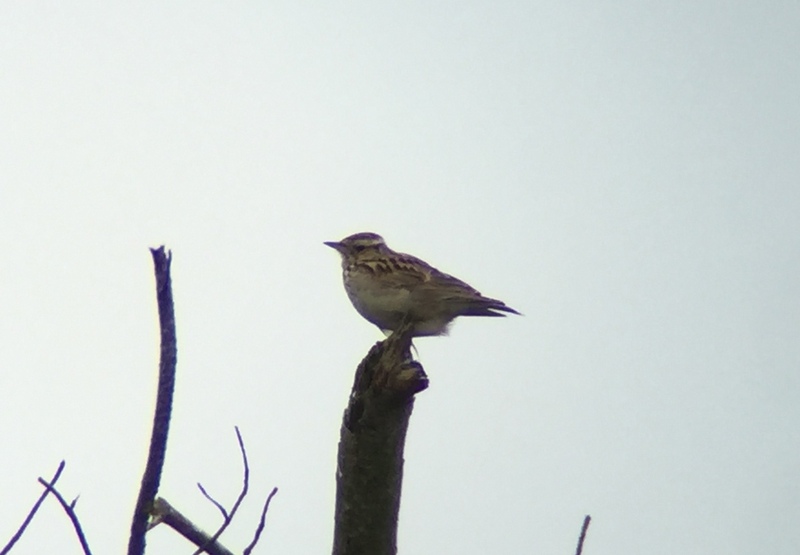 Woodlark – singing from the top of a dead tree
Woodlark – singing from the top of a dead tree
We had a walk round the area where the Dartford Warblers are normally to be found, but this side was very quiet too, apart from more Linnets. A Coal Tit flew out of the pines across in front of us. A Green Woodpecker laughed at us from the trees.
When we heard someone whistling, we turned to see a local birder, who had just walked past, calling to us. We thought at first he was calling us over to say he had found the Dartford Warblers but when we got within earshot he explained that he had just found a Nightjar. We walked back with him and he pointed us straight in the direction of the Nightjar, day roosting on a dead branch out in the open in full view.
Nightjars normally like to roost where they are very hard to see, so this was an unbelievable treat. We got it in the scope and had a great look at it. We could see the finely marked plumage, great camouflage, which would render it invisible on the ground in the leaf litter, but which was no help on the branch it had chosen today!
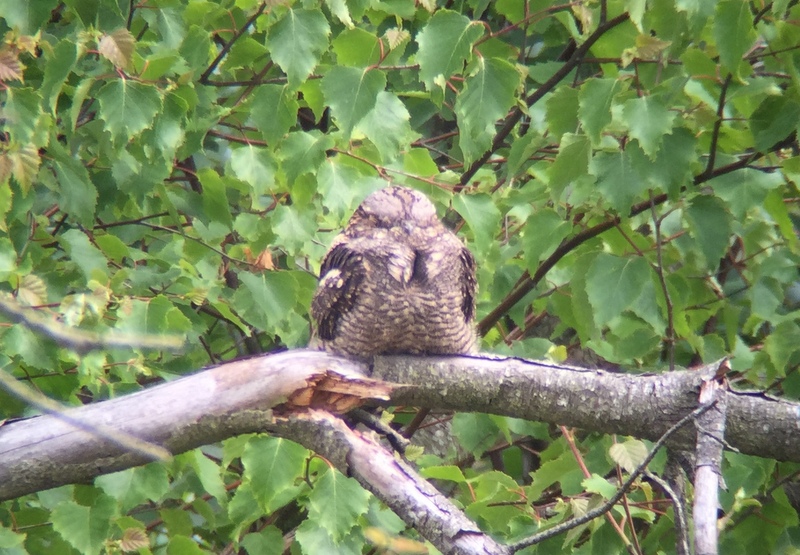 Nightjar – day roosting on a branch out in the open
Nightjar – day roosting on a branch out in the open
We left the Nightjar sleeping quietly and went back to resume our search for the Dartford Warblers. We made another circuit of the area but there was still not a sign, so we made our way back across the Heath to try the first place we had looked again. As we walked up, this time we did hear a Dartford Warbler calling briefly, but it seemed to be heading for a large patch of very dense gorse. We circled round the area a couple of times slowly, but it had all gone quiet again.
It had been a very successful morning on the Heath, with the exception of the warblers, so we decided to move on and try something else. We made our way inland, through farmland behind the coast. We stopped a few times to scan the fields.
It was not a great day to look for raptors on paper, but we saw a good variety on our travels. A Red Kite flew up into a pine tree beside the road with some carrion, while a second soared over above it. We watched the first picking at the food while it perched in the tree. The skies brightened up a bit and, despite the wind, we found several Common Buzzards up, soaring above little blocks of woodland and out across the fields. A Sparrowhawk, flew up high into the sky on bursts of rapid flapping interspersed with glides. And there were Kestrels too, of course.
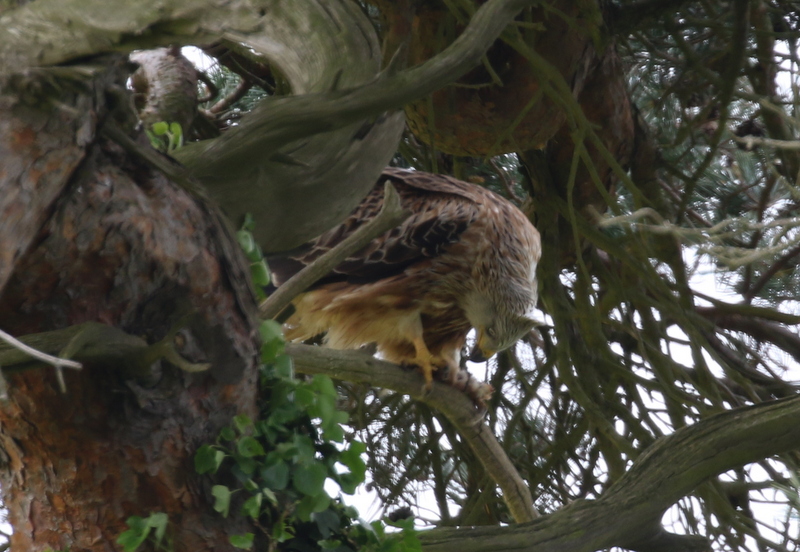 Red Kite – feeding on some carrion, perched in a pine tree
Red Kite – feeding on some carrion, perched in a pine tree
The usual farmland birds were in evidence too. We saw several Yellowhammers and Common Whitethroats in the hedges. A pair of Grey Partridge flushed from the edge of the field made a nice change from the more common Red-legged Partridges and Pheasants. A lovely pair of Stock Doves flew past in front of us and we admired their smart grey wings with distinctive dark trailing edges.
A Lapwing displaying over a massive dry arable field, rowed up for a root crop, will surely struggle to raise a brood here. The family of Shelduck were also still by the large puddle on the edge of a field where we have seen them recently. They too will presumably find life difficult if the water dries up any time soon – it does not seem a sensible place to try to raise a family.
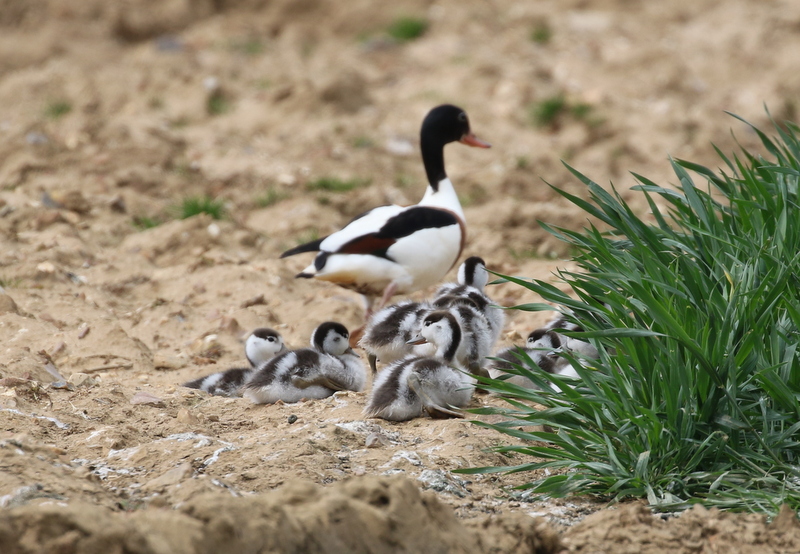 Shelducks – this family continues to survive on a puddle in a field
Shelducks – this family continues to survive on a puddle in a field
After our diversion inland, we dropped back down to the coast at Holkham. We could see several Spoonbills perched in the trees and one did a nice fly round too. There were Little Egrets and Grey Herons around the trees too, and lots of Cormorants on their nests. Out on the grazing marshes were plenty of geese as usual, Greylags and a few Egyptian Geese.
We had originally intended to finish the afternoon on the coast, but one thing was still nagging at us. Despite achieving all our other targets, there was one we had missed – we had not managed to see a Dartford Warbler. The weather had brightened up a little, so we decided to have another go.
When we arrived at the car park, we were told by another birder just leaving that the Dartford Warblers had been showing at one of the sites where we had been this morning. We made our way straight over there, but when we arrived we found it was as quiet as it had been earlier. We made a quick circuit of the area – we could hear Woodlark singing again and a Turtle Dove was perched in the dead trees, although with none of the display activity we had seen earlier. But there was no sign of the Dartford Warblers.
Then we heard a Dartford Warbler call. We walked over to where we thought it had come from, but couldn’t find anything. We tried around the back of the gorse bushes to no avail, but when we walked back round again a small, dark, long-tailed bird zipped across over the back of the heather and dived into the gorse. We made our way straight round on the path to where it seemed to go and suddenly a male Dartford Warbler hopped up onto the top of the heather right in front of us. It cocked its tail in typical Dartford Warbler style, before diving back into cover. A second Dartford Warbler flew out as well. A great view! Finally, our last target bird found.
We backed off and left them in peace, and walked back to the other site where we had tried and failed this morning. Lo and behold, there was another Dartford Warbler, exactly where we had been looking earlier. This one wasn’t right in front of us, so we were able to watch it at a discrete distance. It was a smart male, with dark slate-grey upperparts and deep wine-red underparts. Even better, it then hopped up to the top of some low gorse and started singing.
We heard it call too and then heard another Dartford Warbler calling from behind us. The next thing we knew, a female Dartford Warbler hopped up onto the gorse too, slightly duller coloured both above and below than the male. We watched the two of them feeding in the heather and gorse for a few minutes, before they worked their way back out of view. Fantastic!
 Dartford Warbler – here’s one from a few weeks ago
Dartford Warbler – here’s one from a few weeks ago
We were very pleased we had decided to persevere and come back for a second go for the Dartford Warblers. It rounded out the day nicely, and with that we headed for home.
















